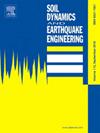关于水平地震激励对临界方向的另一种观点:理论与实例
IF 4.2
2区 工程技术
Q1 ENGINEERING, GEOLOGICAL
引用次数: 0
摘要
本文增强了对水平地震动对应用于结构基础时的临界方向(在所有可能的方向上最大化EDP的响应)的理解。考虑到任何结构响应都包括单个模态的贡献,即使在非弹性偏移的情况下,前几个模态响应的最大化将足以确定大多数edp的临界方向。据此,本文提出了模态取向概念建立的理论背景。对建筑物在一对正交水平激励下的模态响应的分析在理论上等同于对沿该方向的相关单分量表示的分析。使相关振荡器的响应最大化的同一单组分表示的方向称为光谱方向。证明了临界取向是模态取向和谱取向之差。根据这一点,提出了一项关键性方向的建议,无论edp如何,该建议预计将包括大部分edp,如果不是全部的话。虽然这一发展是基于线性分析,但已证明适用于在中强震动下发生非弹性偏移的建筑物。这些建议是基于四个数值例子得出的,这些数值例子涉及对称和非对称建筑在单个水平地面运动对和一系列地面运动的作用下。关于临界方向的建议应纳入抗震设计和性能评估实践。本文章由计算机程序翻译,如有差异,请以英文原文为准。
An alternate perspective on the critical orientation of horizontal pair of seismic excitations: Theory and illustrations
This paper enhances the understanding of critical orientation (that maximizes the response of an EDP over all possible orientations) for horizontal ground motion pairs when applied to the base of a structure. Given that any structural response comprises the contributions from individual modes, even under inelastic excursion, the maximization of modal responses for the first few modes would be sufficient to define the critical orientation for most of the EDPs. In line with this, the theoretical background to establish a concept of modal orientation is presented in this paper. The analysis for the modal response of a building against a pair of orthogonal horizontal excitations is theoretically equivalent to the analysis against the associated single component representation along this orientation. The orientation of the same single-component representation that maximizes the associated oscillator's response is termed as the spectral orientation. The critical orientation is proven to be the difference between the modal and spectral orientations. In line with this, a recommendation is proposed for critical orientation regardless of the EDPs, which is expected to capture most of the EDPs, if not all. Although this development is based on linear analysis, it is demonstrated to be applicable to buildings undergoing inelastic excursion under moderate-to-strong shaking. These recommendations are based on four numerical examples involving symmetric and unsymmetric buildings subjected to individual horizontal pairs of ground motions and also a suite of ground motions. The proposed recommendations on critical orientation should be incorporated into seismic design and performance assessment practices.
求助全文
通过发布文献求助,成功后即可免费获取论文全文。
去求助
来源期刊

Soil Dynamics and Earthquake Engineering
工程技术-地球科学综合
CiteScore
7.50
自引率
15.00%
发文量
446
审稿时长
8 months
期刊介绍:
The journal aims to encourage and enhance the role of mechanics and other disciplines as they relate to earthquake engineering by providing opportunities for the publication of the work of applied mathematicians, engineers and other applied scientists involved in solving problems closely related to the field of earthquake engineering and geotechnical earthquake engineering.
Emphasis is placed on new concepts and techniques, but case histories will also be published if they enhance the presentation and understanding of new technical concepts.
 求助内容:
求助内容: 应助结果提醒方式:
应助结果提醒方式:


